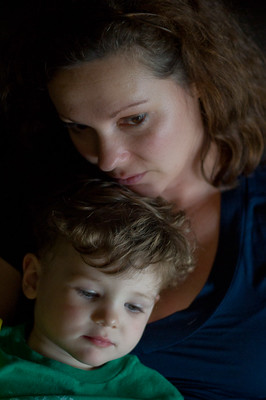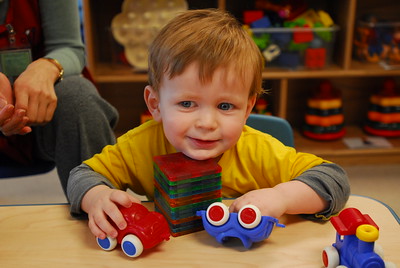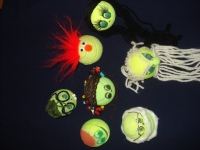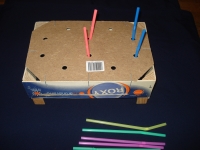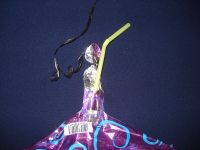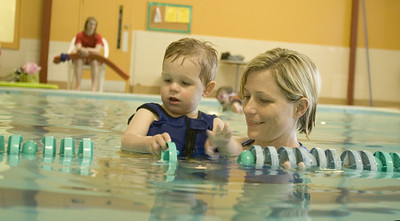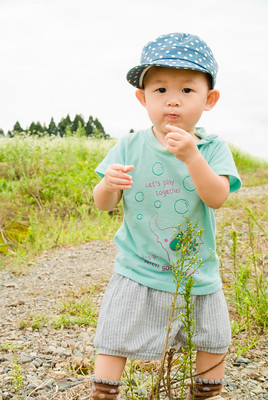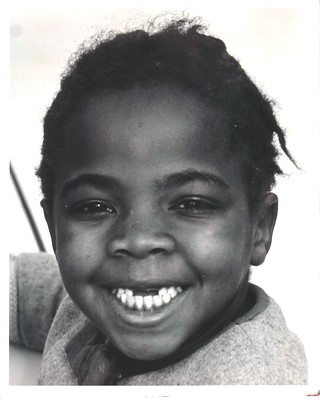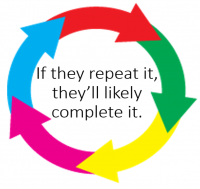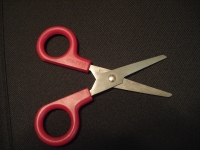Find many creative ideas to get children leaping ahead in their physical development, all while done with things found at home. This is the time to take a minute to watch these and strengthen your options while stuck at home. Enjoy!
A Rule of Thumb: Take children's fear as a very real event for them, even if what they are afraid of doesn't exist (e.g. a monster under the bed). A monster may not be real; but the fear is.
In looking at the brain developing according to age, a preschooler does not have the logic of an adult. Therefore, using logic to talk them out of their fears will not work. This is where compassion and comfort come in. For instance, in the scenario of walking across a slotted bridge with narrow cracks, as long as a child can see through the cracks, they think they will fall through. (Some children may be oblivious to this.) An appropriate response when the child is afraid would be to pick them up and carry them, not try to reason with them about the slots.
In very non-scientific terms, this is what happens when a child is afraid:
Sometimes children lie -- because they're afraid.
Sometimes children lie because they have become afraid of the person they are lying to.
If you think your child is experimenting with lying, begin by writing down every time you observe it happen. What situation did it appear in? What brought it about? You can also keep a chart. You may begin to discern patterns.
9 personality characteristics that parents can notice within the first few months of a baby's life:
- Activity Level
- Rhythmicity -- predictable schedule
- Approach/Withdrawal when presented with something new
- Adaptability (similar to Rhythmicity) -- how they adjust to change/disruption to routine
- Intensity of Reaction -- how strongly they respond (smile/whimper vs chortle/howl)
- Threshold of Responsiveness -- sensitivity to stimuli, e.g. wet nappy, whether right away or after some exposure
- Quality of Mood -- happy a lot vs unhappy a lot
- Distractibility -- how easily they stop fussing with distraction vs not distractible/very focused
- Attention Span -- playing with one toy for a long time vs moving on quickly
This list is to whet your appetite for further reading. Check out the book at your local library.
Berger suggests that children can be stretched in the following 5 of the 9 categories: 1, 3, 6, 8, 9.
Have you given up on your New Year's resolution already? Here are three rules for you and your children as you attempt growth and development together.
Rule 1: Break it down into doable steps.
The Montessori model is an excellent example of this.
In an earlier article on gross motor development, we focused on the upper body as the development stages go from the head down (and the core outward). Today, we would like to revisit gross motor early intervention with a focus on strengthening balance. This is a task that can easily be accomplished in the small moments of daily routine such as while waiting - give the child the challenge to stand on one foot, switch feet, put arms out to the side to help them balance, etc.
We have touched on this topic before in the blog so we'll put some links as well as some additional ideas here for you:
- put a long piece of yarn on the rug making straight lines, then curvy lines along with more ideas listed under pretend balance beams using large steps and small steps (more difficult)
As mentioned previously, children today are learning to type but their hands aren't strong enough to write or do other tasks like being able to eat without spilling on themselves which is a skill that requires hand strength and coordination. People want and need to write legibly and quickly. Arts and crafts, the playing of musical instruments, cooking, measuring....all parts of life require finger strength.
Here is a list of some ways to build finger strength:
- climbing trees or jungle gyms
- folding clothes (make a matching game out of the socks)
- crawl through toy tunnels or cardboard box tunnels
- pretend to be animals and crawl around
- sweep with a child-size broom
- wash the car (or make a car wash tunnel with a garbage bag cut into strips - this can also be seaweed that they can crabwalk through on the ocean floor)
- cooking! stir, knead, cut, roll
- play with playdough or clay (which is even better for strengthening)
- give the baby doll a bath or handwash the doll clothes - wring them dry and hang them out on the line with clothespins
- sewing cards that progress to learning stitches, sewing on a button, and more
- ball puppets (see below)
How to make a ball puppet:
The most common use of fine motor muscles today may be learning to use a keyboard which is a wonderful skill to have but has the touchscreen surpassed that, or voice commands? We urge you to not forget to work on the development of finger and hand muscles in your wee ones. There is a fine motor progression we will follow to give you a better idea of how to work your way into this.
In all of these activities, it is important for the adult to participate with the child in the activity before letting them do it on their own while the adult is involved in something else nearby.
At around the age of six months or as soon as they can sit up, sit them next to the drawer where the plasticware is kept and let them take everything out and put it back in again. This will speed up the myelination (development of their nerves) of their arms, hands, fingers. They will be wobbly at first but progress to becoming on target. The next step could be to introduce a shape sorter toy.
Strengthening large muscle groups (gross motor skills) helps with balance, strength, eye-hand coordination, eye-foot coordination, and overall body coordination (proprioception). This can be done in many ways and starting from an early age. It is important to help your child learn to be aware of where there body is in space. As we go through some techniques to developing these skills, there is a general guideline to remember: Children develop from the head down and from the center of the body outward...the head develops before the feet and the shoulders before the hands.
In all of these things it is important to remember to never tease a child by calling them a clutz. Even if they have these tendencies, early intervention can help with that.
From early on, eye-hand coordination can be developed with the use of a mylar balloon hanging from above (on a mobile, etc.) so that the child can watch it. It is light and small enough that the child can make it move easily. Infants move their bodies to practice using their muscles. If they can make something else move at the same time, they will do it more!
Does your gene pool have learning challenges in the mix: ADD/ADHD/autism/dyslexia? Studies of children diagnosed with autism show that early intervention has helped to the point that the autism was undetectable. There are also early intervention techniques for physical challenges. Almost any problem that presents itself in childhood can be helped if we work with the child in fun and helpful ways. Involving as many senses as possible in the learning process including physical activities is a key factor. If the body can move while learning, by the time a child is school-age the brain will have made all kinds of new connections.
Maria Montessori, the first female doctor in 19th century Italy, saw children labelled "mentally retarded" and believed they could learn. She broke everything down into small components and taught using the body through doing activities that laid the groundwork for math, language, and all other learning. After Montessori worked with them, the same children with these labels on their identity were then able to pass the exams taken by "normal" children.
Let's look at some ways to employ this technique to break math down into small parts. For a child to learn math it has to be pieced apart:
The development of the ability for delayed gratification can be done from an early age. Increasing one's attention span will eventually affect many aspects of life from saving money to controlling a temper or facing temptation to do the wrong thing. It is important to start at the beginning.
The fact is the younger the age, the shorter the attention span. Infants have needs that should be met immediately. They need to know that their needs will be taken care of and this is exactly where they should be at developmentally. Toddlers have enough ability to wait with distraction or accept help to accomplish the thing for which they're waiting. Preschoolers can be stretched to increase their ability to wait with some help.
If you're curious where your child's attention span is at, try this little test... Place a raisin or M&M under a cup making sure your child sees what you're doing. Then explain that they can pick up the cup and eat it AFTER you ring the bell. (You can do this with lunch food or anything you approve of but keep it small so they don't fill up too quickly.) For the first ringing of the bell, ring right away. On the second attempt, ring the bell after a few seconds' delay. With each subsequent ringing, lengthen the time by a little longer each turn to try to stretch them. Some children will be able to wait and some won't. If they cannot wait for the bell, still watch the clock and ring the bell anyway as they will have to wait for it on the next round. Don't get upset. This is just an area to work on. Sidenote: don't play this when they're really hungry but when they still want a little food, like at snack time.
Travelling with children can be a special time, even on a road trip! The kids have the potential to triple their vocabulary on a week-long car trip if that's what is chosen to work on. Relationships among family members can improve with interactive car games. Whether infant, toddler, or early elementary, littles can have fun and leap ahead in cognitive development and fine motor skills while en route to your holiday destination.
While technology is a very handy tool to have when travelling, make sure your children are not on their devices the whole travel time. Pack a backpack/travel bag per child that they may fill with their travel treasures. Elementary age children can usually make independent choices on what to leave and what is important to bring. This may include dolls (with add-ins of ribbons, pieces of fabric, etc.) that would be useful for making up stories so be sure to include several that can interact with each other. Comic books, graphic novels, magazines, coloring books, and educational workbooks are all lightweight for easier transportation. Crayons are recommended over markers for use in the car but be sure to keep them in a baggie in case there is weather hot enough to melt them.
A separate family trip bag can be filled with toys that are never seen except for on a trip. These toys might be:
Children tend to not handle change well. Their brain has trouble shifting gears, similar to a railway car in need of assistance to shift tracks. Some children are better with change than others. This is based on personality or temperament. But regardless of their personality or temperament, there are ways we can help our children learn to deal with life’s inevitable challenges that come with change.
- They need routines.
If you can have a fairly stable routine (e.g. “This is what we do at this time of day…”), children tend to relax and exhale at the thought of knowing what is coming next.
- They need rules/expectations that are consistent, that they can count on.
Children need to know what is expected of them and that it is not going to change. If you make a rule, try your best to stick with it. Yes, new rules will happen at different ages and these can be discussed ahead of time if there is a change coming. When this is appropriate, it is helpful to stop, get on the child’s level, look them in the eye, and describe the new expectation. Then have them repeat it.
When Kirby Worthington, co-founder of Growth and Giggles, was working toward her Master’s degree, she spent time as a director of a Montessori preschool. She had read research on repetition and decided to test it out. On a very cold winter’s day, after three days of freezing rain and no outside playtime at school, the sun came out and it was time to go outside again. However, under the swing there was a giant mud puddle full of the freezing rain. Before going outside she gathered the children and told them: “We’re going to get to play outside, and you can play on any of the equipment – except no swinging today”, and she explained about the puddle. As they went out the door, she stopped each child asking them, “Where are you NOT playing today?” And they would repeat back to her, “No swinging and no playing in the mud.” Do you know, the experiment worked and not one child broke the rule. She was outside observing their behavior and, sure enough, they had in their minds what to do and what not to do. And they stuck to it.
If they repeat it, they’ll likely complete it.
If you get children to say the rule or expectation, they’ll generally choose to listen to it. (Not always, of course; let’s be realistic!) It helps to have them repeat it the first time. But what really helps is to have them repeat the rule every time you have that expectation of them.
Three-year-old Jonathan would not go anywhere without wearing a hat. He called it his "helmet." One day, Kirby and Jonathan were out walking in the woods, and Jonathan realized that he had forgotten his helmet. He started to get panicky. Kirby quickly offered him the knit hat she was wearing because of the cold, and he calmed down.
After a while, Kirby asked him, "How do you like wearing my helmet?"
Jonathan replied, "I like it. It keeps me from falling down."
Kids like moving their bodies! Here are three fun activities that build flexibility, balance, strength, and coordination.
Safety Tip: Remember, do not force yourself (or children) to flex farther than is comfortable, with a slight pulling feeling in the muscles. Hold the stretch, then gently stretch a bit further. Never force a stretch. |
Crab walk: Have children sit with their knees bent, feet flat on the floor in front of them, feet apart. Next show them how to place their hands down by their sides, but slightly behind their backs. Then, they can raise their hips off the floor. Now they can walk forward, backward, and sideways, pretending to be crabs.
 Parents of preschoolers are tired people. Caring for little ones is exhausting work. We have the best intentions of providing enriching activities for our kids, but when exhaustion sets in, good intentions go out the window. To help you plan for those times when you need something your child can do while you are lying down or sitting, here's a list of 20 activities.
Parents of preschoolers are tired people. Caring for little ones is exhausting work. We have the best intentions of providing enriching activities for our kids, but when exhaustion sets in, good intentions go out the window. To help you plan for those times when you need something your child can do while you are lying down or sitting, here's a list of 20 activities.
- Finger paint in shaving cream spread on a cookie sheet.
- Play with play dough.
- Read. If you're reading a well-known book, try changing some of the words or sentences and let your child have fun catching your "mistakes."
- Play Chutes and Ladders or Candyland.
- Put on music and let your child dance. Try giving her a bean bag and challenge her to dance with the beanbag on her head, between her knees, or on her elbow.
- Play "red light, green light."
- Play a following directions game. Give your child silly things to do.
- Put out two or three items on a plate, then cover them up and see if your child can remember what he saw. Let him do the same for you.
- Throw a sheet over a card table to make a fort. Let your child take toys inside.
- Put a little tub of water on the kitchen floor. Gather up a bunch of objects and let your child test if they sink or float.
- String big beads on shoelaces.
When my oldest daughter was 15 months old, her dad built a sandbox. I (Kirby) knew it was going to be perfect! I could hang clothes out to dry while my toddler blissfully discovered pouring and measuring and building and dumping. Montessori had come to my house!
I gathered up my basket of wet clothes, led my little girl over to the new sandbox, and headed for the clothesline. But she just stood there, staring at the sand and looking puzzled. Then it hit me—she didn't know how to play with sand. So I abandoned my laundry and we spent time making mountains together and filling up her dump truck, pouring water onto the sand, and digging holes. After that, she knew what to do, and she knew how much fun it could be.
It's not just kids who haven't learned how to play with sand. Lots of parents don't know what to do with a sandbox either. So here's a list of activities you can do with your pre-schooler in the sand. All of these games build cognitive and physical skills too.
It's back-to-school time! Like with every decision, parents agonize over preschool options. Do you send your child to preschool? What kind? Would your child be better off at home? Will they be ready for kindergarten if you opt out of preschool?
To help you think through your options, here's a basic checklist of what kids need to know to succeed in kindergarten. You can help your child learn these things at home, or they can gain this knowledge through any number of preschool programs.
Language and Pre-reading skills:
Bouncing spirals hanging from the ceiling fan. Paper dolls. Hula skirts for toys. Fringed placemats. Paper-plate angels. Toilet-paper-tube puppets. When you know how to use scissors, you can make the best crafts!
So how do you teach the skills necessary for all those fun crafts?
Introduce the Scissors


